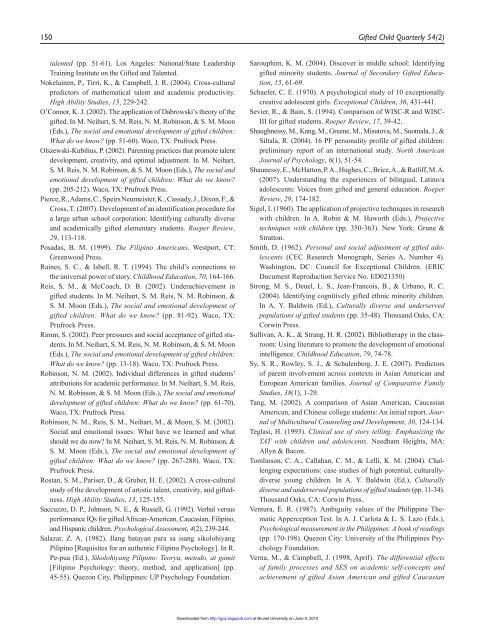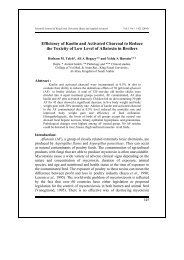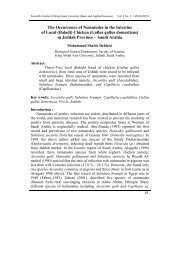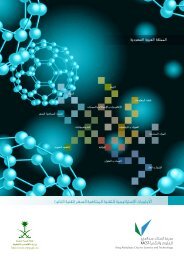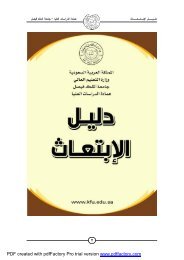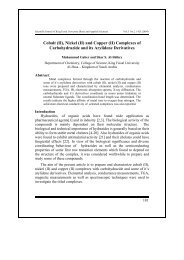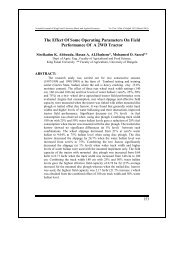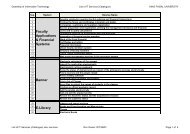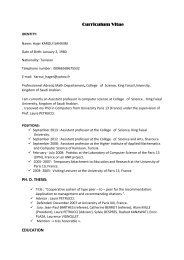Gifted Child Quarterly
Gifted Child Quarterly
Gifted Child Quarterly
Create successful ePaper yourself
Turn your PDF publications into a flip-book with our unique Google optimized e-Paper software.
150 <strong>Gifted</strong> <strong>Child</strong> <strong>Quarterly</strong> 54(2)talented (pp. 51-61). Los Angeles: National/State LeadershipTraining Institute on the <strong>Gifted</strong> and Talented.Nokelainen, P., Tirri, K., & Campbell, J. R. (2004). Cross-culturalpredictors of mathematical talent and academic productivity.High Ability Studies, 15, 229-242.O’Connor, K. J. (2002). The application of Dabrowski’s theory of thegifted. In M. Neihart, S. M. Reis, N. M. Robinson, & S. M. Moon(Eds.), The social and emotional development of gifted children:What do we know? (pp. 51-60). Waco, TX: Prufrock Press.Olszewski-Kubilius, P. (2002). Parenting practices that promote talentdevelopment, creativity, and optimal adjustment. In M. Neihart,S. M. Reis, N. M. Robinson, & S. M. Moon (Eds.), The social andemotional development of gifted children: What do we know?(pp. 205-212). Waco, TX: Prufrock Press.Pierce, R., Adams, C., Speirs Neumeister, K., Cassady, J., Dixon, F., &Cross, T. (2007). Development of an identification procedure fora large urban school corporation: Identifying culturally diverseand academically gifted elementary students. Roeper Review,29, 113-118.Posadas, B. M. (1999). The Filipino Americans. Westport, CT:Greenwood Press.Raines, S. C., & Isbell, R. T. (1994). The child’s connections tothe universal power of story. <strong>Child</strong>hood Education, 70, 164-166.Reis, S. M., & McCoach, D. B. (2002). Underachievement ingifted students. In M. Neihart, S. M. Reis, N. M. Robinson, &S. M. Moon (Eds.), The social and emotional development ofgifted children: What do we know? (pp. 81-92). Waco, TX:Prufrock Press.Rimm, S. (2002). Peer pressures and social acceptance of gifted students.In M. Neihart, S. M. Reis, N. M. Robinson, & S. M. Moon(Eds.), The social and emotional development of gifted children:What do we know? (pp. 13-18). Waco, TX: Prufrock Press.Robinson, N. M. (2002). Individual differences in gifted students’attributions for academic performance. In M. Neihart, S. M. Reis,N. M. Robinson, & S. M. Moon (Eds.), The social and emotionaldevelopment of gifted children: What do we know? (pp. 61-70).Waco, TX: Prufrock Press.Robinson, N. M., Reis, S. M., Neihart, M., & Moon, S. M. (2002).Social and emotional issues: What have we learned and whatshould we do now? In M. Neihart, S. M. Reis, N. M. Robinson, &S. M. Moon (Eds.), The social and emotional development ofgifted children: What do we know? (pp. 267-288). Waco, TX:Prufrock Press.Rostan, S. M., Pariser, D., & Gruber, H. E. (2002). A cross-culturalstudy of the development of artistic talent, creativity, and giftedness.High Ability Studies, 13, 125-155.Saccuzzo, D. P., Johnson, N. E., & Russell, G. (1992). Verbal versusperformance IQs for gifted African-American, Caucasian, Filipino,and Hispanic children. Psychological Assessment, 4(2), 239-244.Salazar, Z. A. (1982). Ilang batayan para sa isang sikolohiyangPilipino [Requisites for an authentic Filipino Psychology]. In R.Pe-pua (Ed.), Sikolohiyang Pilipino: Teorya, metodo, at gamit[Filipino Psychology: theory, method, and application] (pp.45-55). Quezon City, Philippines: UP Psychology Foundation.Sarouphim, K. M. (2004). Discover in middle school: Identifyinggifted minority students. Journal of Secondary <strong>Gifted</strong> Education,15, 61-69.Schaefer, C. E. (1970). A psychological study of 10 exceptionallycreative adolescent girls. Exceptional <strong>Child</strong>ren, 36, 431-441.Sevier, R., & Bain, S. (1994). Comparison of WISC-R and WISC-III for gifted students. Roeper Review, 17, 39-42.Shaughnessy, M., Kang, M., Greene, M., Misutova, M., Suomala, J., &Siltala, R. (2004). 16 PF personality profile of gifted children:preliminary report of an international study. North AmericanJournal of Psychology, 6(1), 51-54.Shaunessy, E., McHatton, P. A., Hughes, C., Brice, A., & Ratliff, M. A.(2007). Understanding the experiences of bilingual, Latino/aadolescents: Voices from gifted and general education. RoeperReview, 29, 174-182.Sigel, I. (1960). The application of projective techniques in researchwith children. In A. Robin & M. Haworth (Eds.), Projectivetechniques with children (pp. 350-363). New York: Grune &Stratton.Smith, D. (1962). Personal and social adjustment of gifted adolescents(CEC Research Monograph, Series A, Number 4).Washington, DC: Council for Exceptional <strong>Child</strong>ren. (ERICDocument Reproduction Service No. ED021350)Strong, M. S., Deuel, L. S., Jean-Francois, B., & Urbano, R. C.(2004). Identifying cognitively gifted ethnic minority children.In A. Y. Baldwin (Ed.), Culturally diverse and underservedpopulations of gifted students (pp. 35-48). Thousand Oaks, CA:Corwin Press.Sullivan, A. K., & Strang, H. R. (2002). Bibliotherapy in the classroom:Using literature to promote the development of emotionalintelligence. <strong>Child</strong>hood Education, 79, 74-78.Sy, S. R., Rowley, S. J., & Schulenberg, J. E. (2007). Predictorsof parent involvement across contexts in Asian American andEuropean American families. Journal of Comparative FamilyStudies, 38(1), 1-29.Tang, M. (2002). A comparison of Asian American, CaucasianAmerican, and Chinese college students: An initial report. Journalof Multicultural Counseling and Development, 30, 124-134.Teglasi, H. (1993). Clinical use of story telling: Emphasizing theTAT with children and adolescents. Needham Heights, MA:Allyn & Bacon.Tomlinson, C. A., Callahan, C. M., & Lelli, K. M. (2004). Challengingexpectations: case studies of high potential, culturallydiverseyoung children. In A. Y. Baldwin (Ed.), Culturallydiverse and underserved populations of gifted students (pp. 11-34).Thousand Oaks, CA: Corwin Press.Ventura, E. R. (1987). Ambiguity values of the Philippine ThematicApperception Test. In A. J. Carlota & L. S. Lazo (Eds.),Psychological measurement in the Philippines: A book of readings(pp. 170-198). Quezon City: University of the Philippines PsychologyFoundation.Verna, M., & Campbell, J. (1998, April). The differential effectsof family processes and SES on academic self-concepts andachievement of gifted Asian American and gifted CaucasianDownloaded from http://gcq.sagepub.com at Brunel University on June 9, 2010


